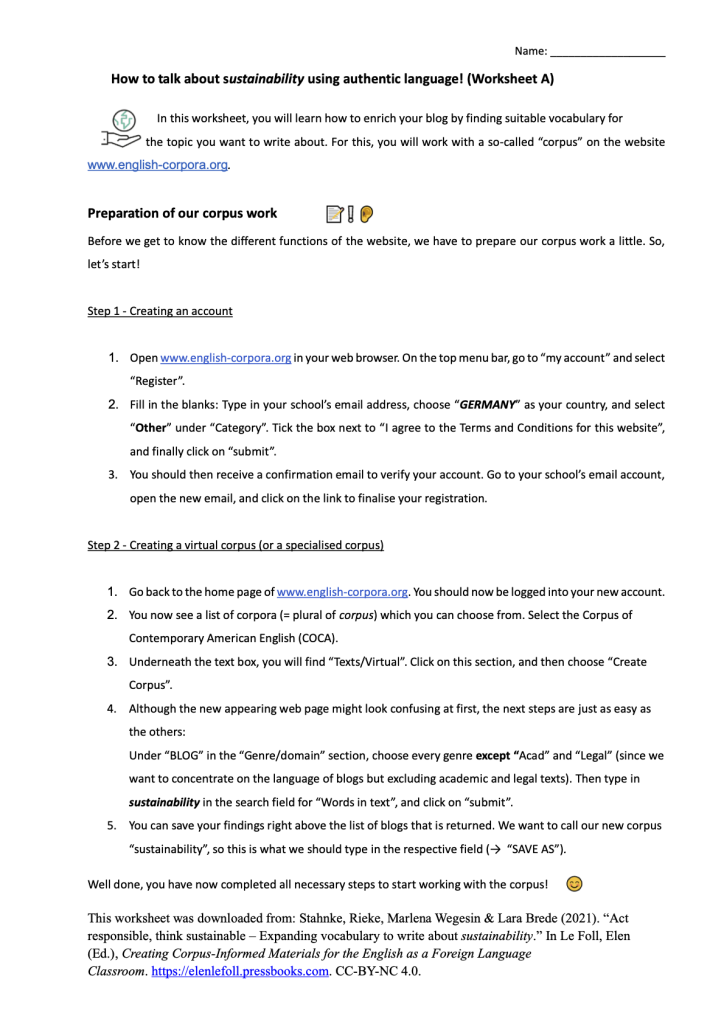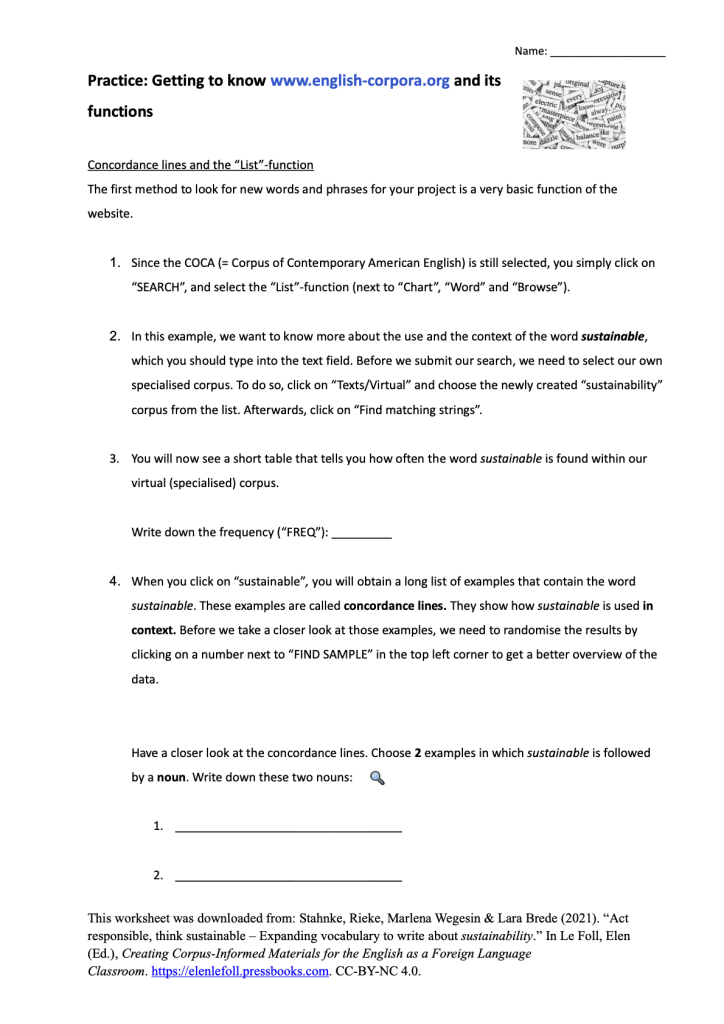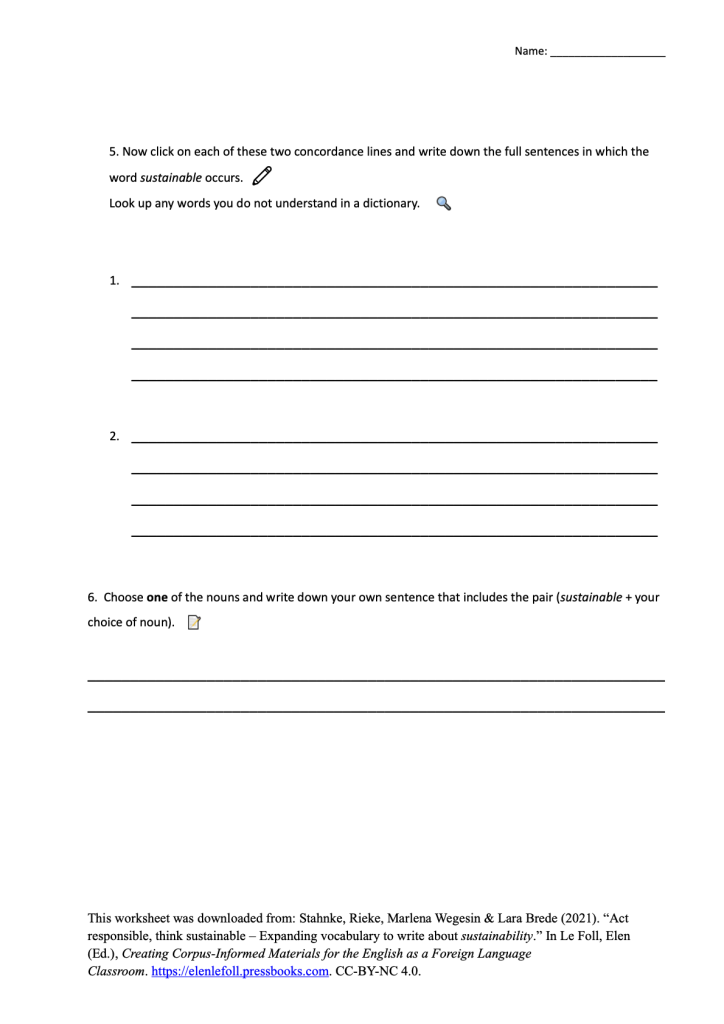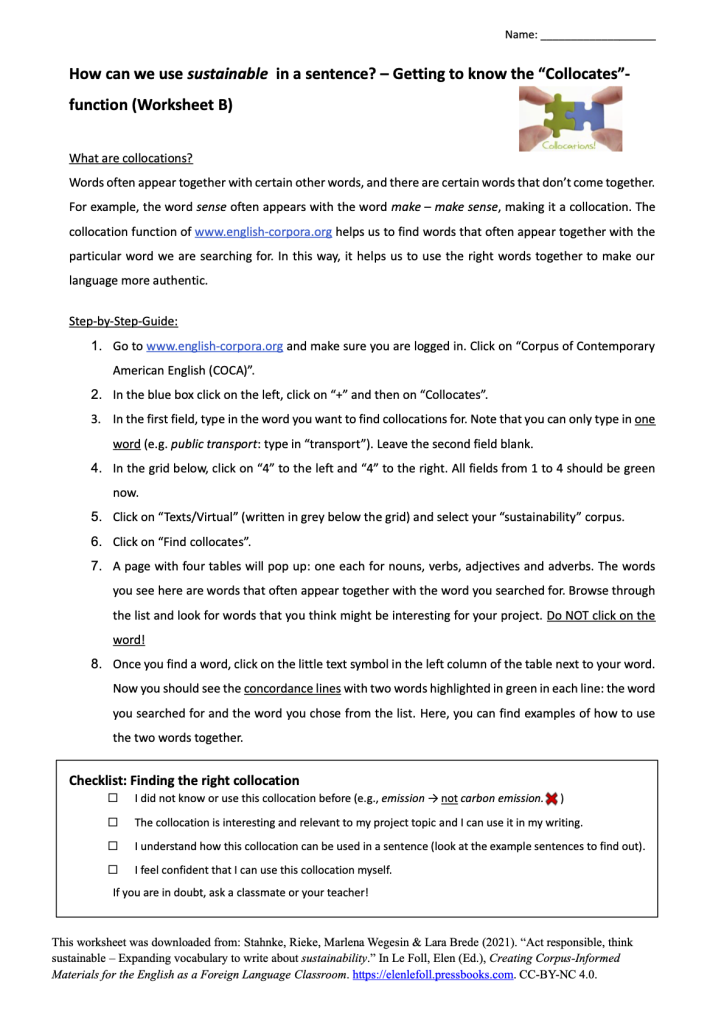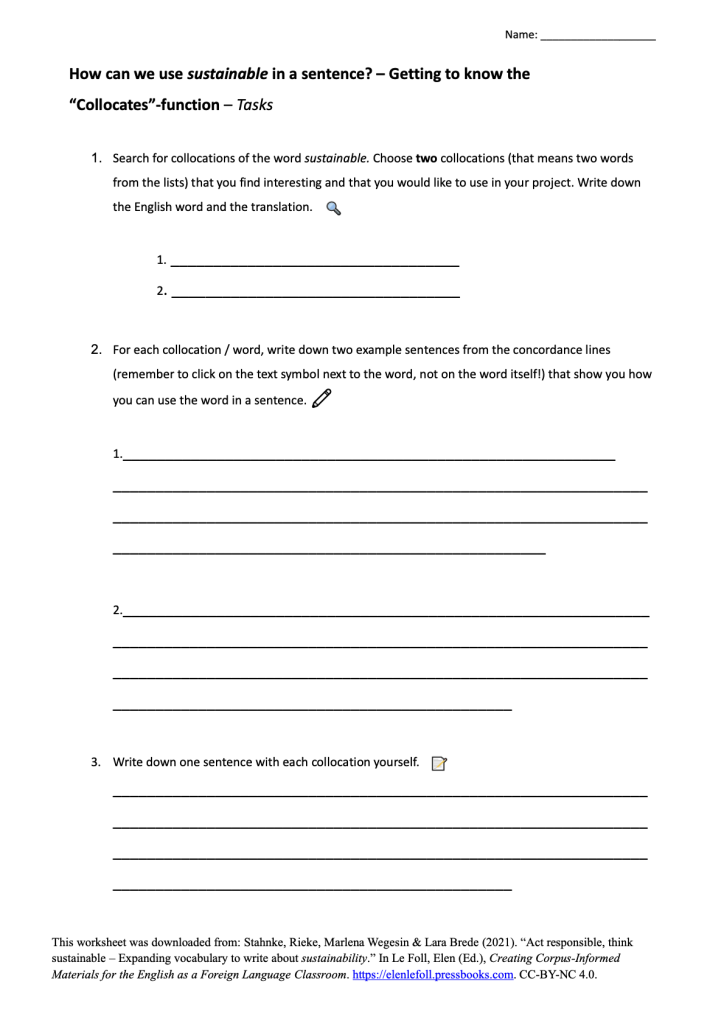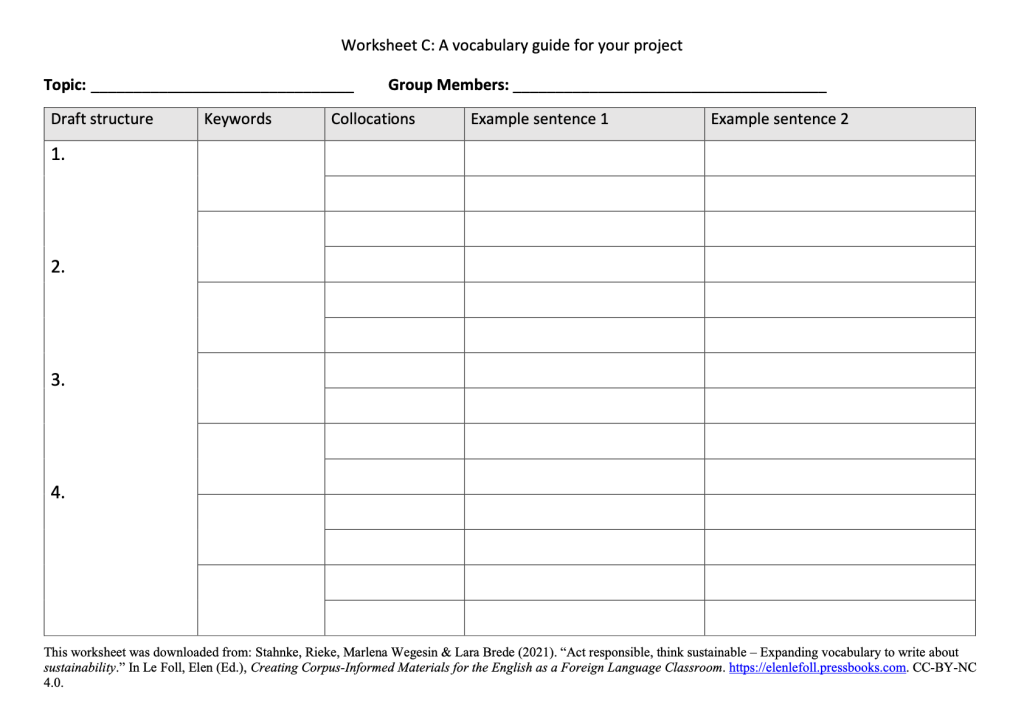Lesson ideas: Content and Language Integrated Learning (CLIL) at secondary school
12 Act responsible, think sustainable – Expanding vocabulary to write about sustainability
Rieke Stahnke; Marlena Wegesin; and Lara Brede
1 Introduction and rationale
Project-based teaching has become increasingly popular. The method is deemed to be potentially highly beneficial in terms of student engagement, independent and social learning, as well as offering many options for differentiation within mixed ability groups. However, conducting projects is often labour-intensive for teachers. Especially in English Language Teaching (ELT), project work often requires students to acquire subject-specific linguistic skills.
This chapter aims to present a flexible approach for providing students with the necessary linguistic support to conduct project work while also keeping the time needed for teacher preparation at a minimum. By teaching students how to use basic strategies of corpus linguistic research, this method will enable students to find the lexical information they need for the specific topic of their choice. This allows for more freedom and differentiation, and also guides the students to think of language as lexical patterns rather than as strings of individual words.
As an exemplary context in which the presented approach can be taken, this chapter outlines a project about sustainability, which is a highly topical issue in today’s world and, thus, very relevant to students’ lives. The main objective is to enable students to talk and write about topics of their own interests related to sustainability and to express personal opinions and emotions about them, which is in line with the secondary school curriculum of Lower Saxony, Germany (Niedersächsisches Kultusministerium 2015: 19, 23).
Outline and learning objectives
- Target learners: Intermediate to upper-level students at secondary school
- Intended product of the project: A blog entry, podcast or video
- Prior knowledge: Students have acquired some knowledge and key vocabulary on sustainability
- Previous lessons: In groups, students have decided on their final topics for their projects and created a draft outline for their writing including key topics and arguments
Preparatory lesson 1 introduces data-driven learning using the “List”-function
- Preparation time: 20 min (or less if you are already familiar with www.english-corpora.org)
- Lesson time: 45 min
Practice lesson 2 uses data-driven learning to find collocations for key vocabulary for the students’ project ideas
- Preparation time: 25 min
- Lesson time: 90 min
Learning objectives
By the end of the second lesson, students should…
- understand the benefits of using corpora to express themselves in idiomatic and natural English,
- understand the meaning and use of collocations,
- be able to use basic functions of the corpus tool to independently search for idiomatic language (word pairs, collocations and example sentences) relevant to their project topic, and
- have contextualised and expanded their existing vocabulary about sustainability in preparation for working on their projects.
2 Corpus, tools and methods
The corpus used in this chapter is the Corpus of Contemporary American English (COCA), freely accessible on www.english.corpora.org/COCA. It provides the option to look exclusively at the language of blogs (assuming that the language of blogs is comparable to the language of podcasts and videos), and includes a large number of recent texts, which is vital for a topic like sustainability that has rapidly gained public attention in the past few years. Moreover, the COCA works best for finding collocations on www.english-corpora.org, as it automatically groups words by part-of-speech, making its output more learner-friendly.
In the lessons, students will first use the “Texts/Virtual”-function to create a virtual corpus (their own subcorpus of the COCA) that only includes blogs about sustainability. They will then continue to explore this subcorpus by means of the “List”-, and “Collocates”-functions to find idiomatic language.
3 Step-by-step guide
3.1 Teacher Preparation
Creating a virtual corpus
Go to www.english-corpora.org. You should see a list of the corpora available on the website. Click on “Corpus of Contemporary American English (COCA)” (Fig. 1):
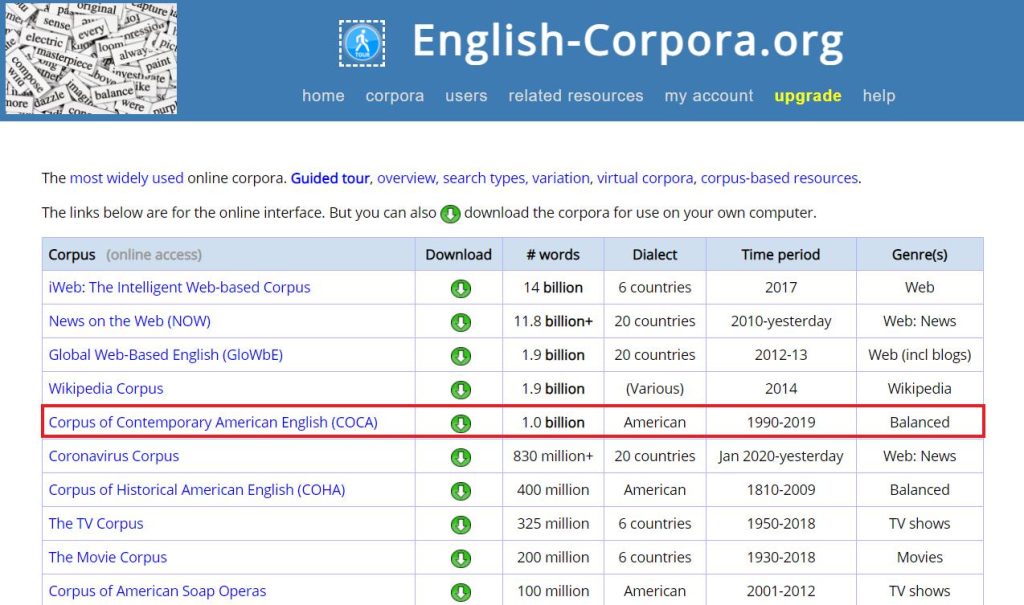
Make sure that you are logged in, as you will create a virtual corpus on your account, i.e., it will only be visible to you (Fig. 2) (If you have not used the website before, you will need to register first by clicking on “My account” in the menu and then “Register” and filling out the required form. This is free and takes no longer than a minute).
Select “Texts/Virtual” in the blue box on the right, and click on “Create corpus “(Fig. 2).
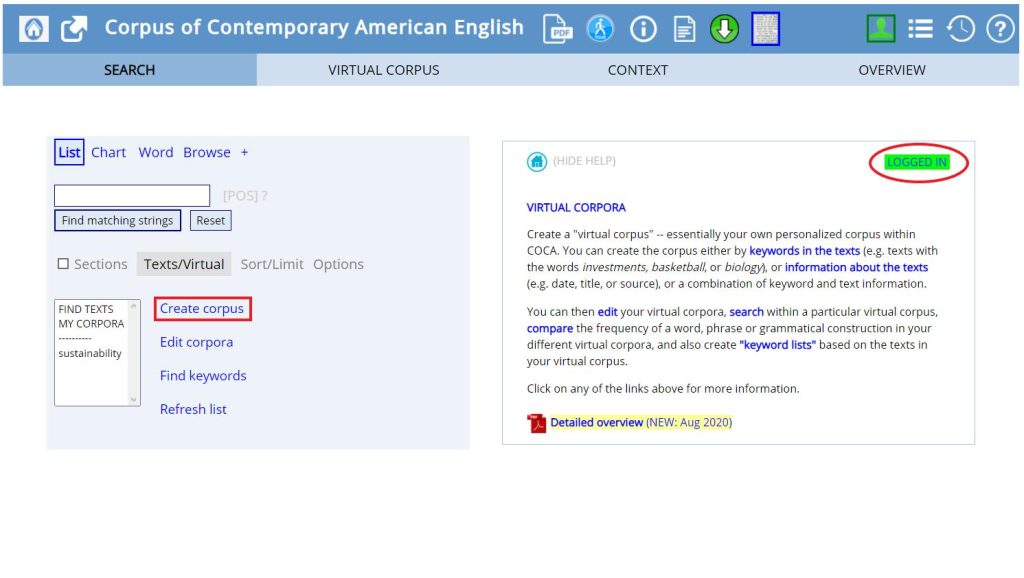
You should now see a search form (Fig. 3) that allows you to select certain texts from the COCA to include in your virtual corpus. For our purposes, we only want to include texts of the genre “Blog”. However, to exclude highly specialized texts with academic language, we will not select the subgenres “ACAD” and “LEGAL”. To do so, press “Ctrl” on your keyboard and click the individual subgenres of “BLOG” in the list, leaving out “ACAD” and “LEGAL” (Fig. 3).
To only include texts that are relevant to the topic of our project, type sustainability in the field next to “Words in text”. Then press “Submit” (Fig. 3).
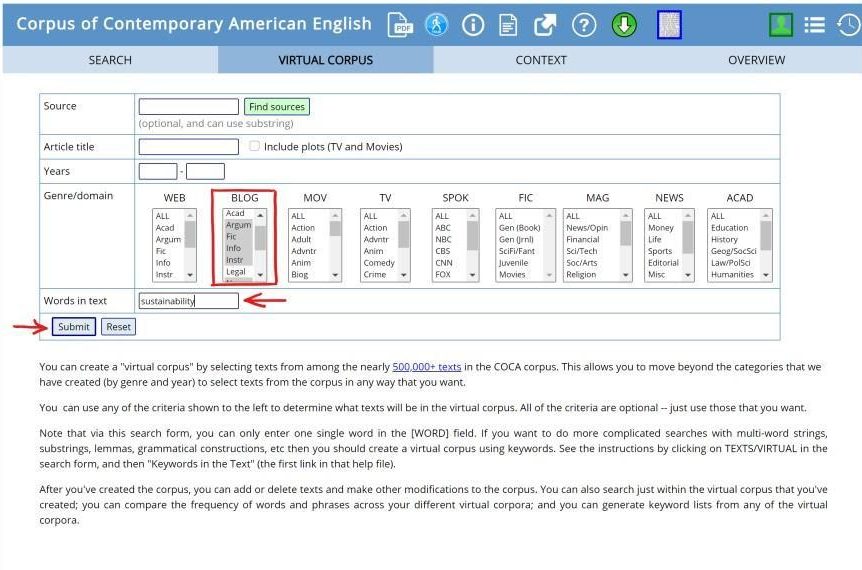
On the next page, you will find a list of all the texts your query has returned. Give your virtual corpus a name (e.g., sustainability) by typing it in the field next to “SAVE AS” and finally click “SUBMIT” (Fig. 4) to finish building your virtual corpus (Fig. 5).
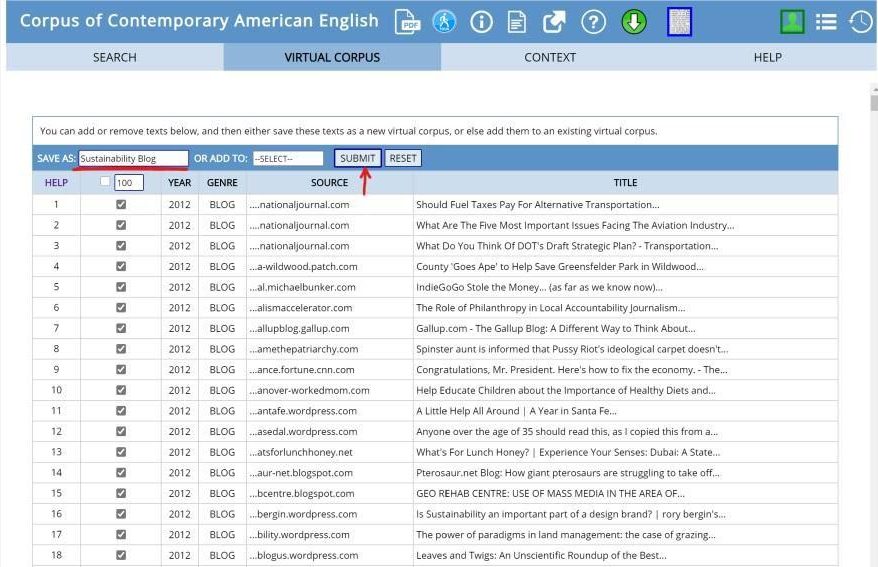

Preparing the warm-up activity
The warm-up activity aims to show students the benefits of using corpora to obtain information about how words are naturally used together by asking what verb (maintain, preserve, retain, etc.) is most frequently associated with biodiversity. As preparation, search for the results in the full corpus:
Choose the COCA, click on the “+” next to “Browse” and then on “Collocates”.
Then type biodiversity into the “Word/phrase” search field, click on “POS” (part of speech) next to “Collocates”, choose “verb.ALL”, and select one position to the left (= verb that precedes biodiversity by one position within the sentence).
Next, click on “Options”, and let your search results be grouped by “LEMMAS” to make sure that conjugated verb forms do not result in duplicated findings (Fig. 6).
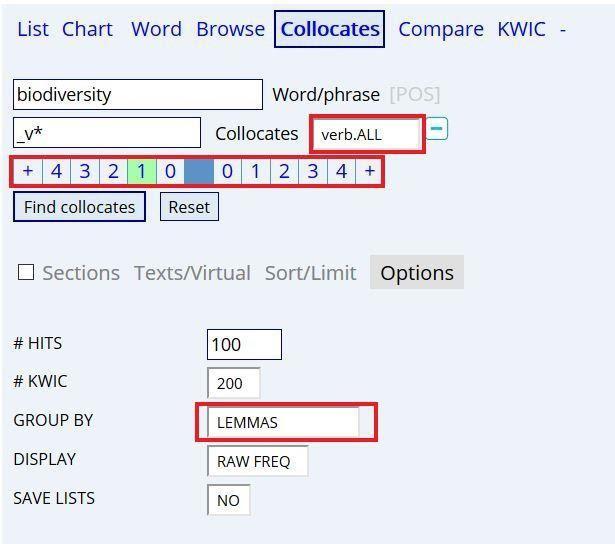
In this case, do not choose the newly-created virtual corpus, as the whole content of the COCA will provide more results.
Submit your search (“Find collocates”) to obtain a list of the most frequent verbs co-occurring with biodiversity (Fig. 7).
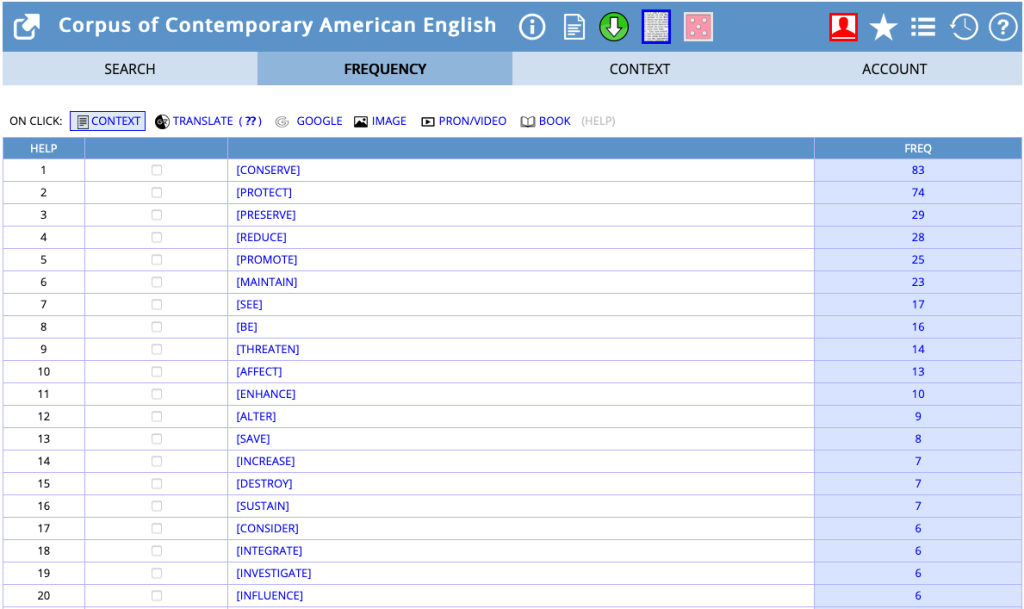
Take a screenshot which you can present to your students during the warm-up of the second lesson.
For the first warm-up activity, select the first five findings, and click on “CONTEXT” just above the first verb of the list (Fig. 7).
Randomise your results afterwards (by clicking on a number next to “Find sample” in the top left corner of the result list) and take a screenshot to present in class.
Getting to know the “List”-function
Next, you should become familiar with the tasks that are used in the lesson and try out the “List”-function so that you can walk your students through the steps in class.
Go to the COCA again and type the word sustainability in the search box. This word serves as an example to show how the “List”-function works.
Limit your search to your virtual corpus by clicking on “Text/Virtual”, select your corpus (here: sustainability) and click on “Find matching strings” (Fig. 8).
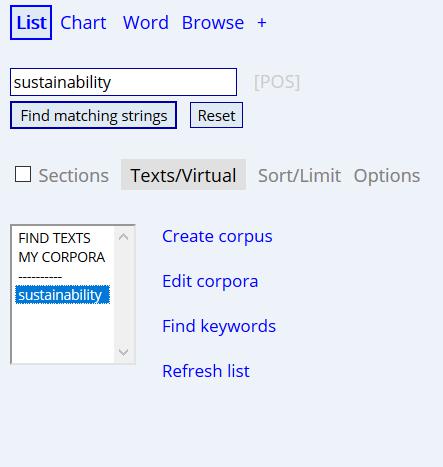
You will find a very short table that tells you how often sustainability appears in the corpus. Click on the word itself (Fig. 9) to obtain a list of examples of texts that feature the noun sustainability (Fig. 10).

These examples are called concordance lines. Click on any number in the top left corner (Fig. 10) to randomise the search and thus gain a more varied overview of how the word is used in different contexts.
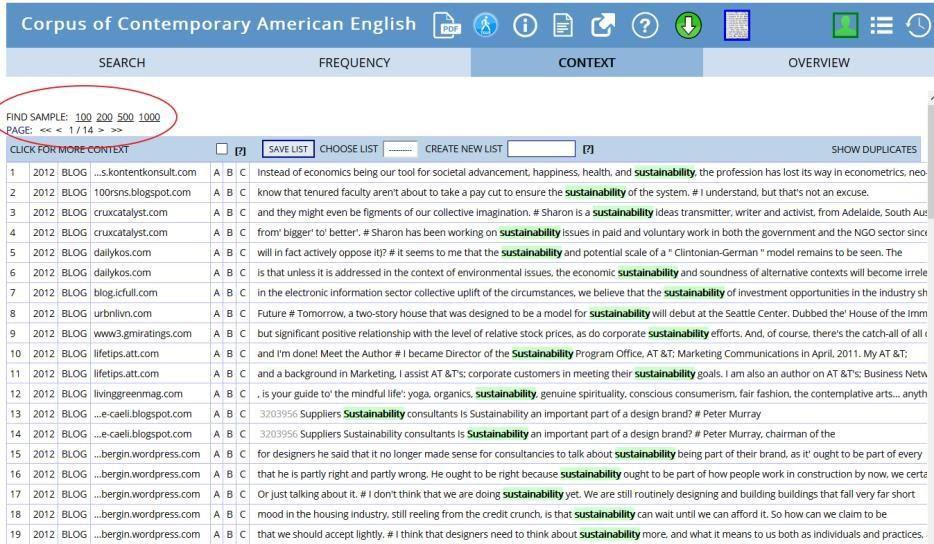
3.2 Lesson 1
Plan for the first lesson
Duration: 45 minutes
| Phase | Task |
Implementation |
Interaction form |
Materials |
| (1) Warm-Up 5 min |
Translating:Wir müssen die Artenvielfalt erhalten. | Problematisation of translating etwas erhalten without considering the context | Plenum | Electronic devices* |
| (2) Preparation 15 min |
Preparation of corpus work | Creating an account and a virtual corpus on www.english-corpora.org Following the instructions on the worksheet |
Individual work | Electronic devices, Worksheet A |
| (3) Practice 15-20 min |
How can we use sustainable in a sentence? | Using the “List”-function and working with concordance lines Practising data-driven learning |
Individual/ partner work | Electronic devices, Worksheet A |
| (4) Conclusion 5-10 min |
How did it go? | Sharing results and discussing problems Outlook on next lesson |
Plenum | ——- |
* = interactive whiteboard, students’ computers/laptops
Tasks and instructions
Warm-up
Wir müssen die Artenvielfalt erhalten.
The warm-up activity serves not only to activate students’ cognitive skills, but also to make them aware of the relevance of corpus work for being able to express themselves accurately and idiomatically in English. For this purpose, select a topic-related sentence in the students’ first language which includes at least one word that is problematic with regard to its translation into English. In this chapter, the German sentence Wir müssen die Artenvielfalt erhalten (‘We need to conserve biodiversity’) has been chosen to highlight the ambiguous meaning of the verb erhalten, which, in other contexts, could just as well be translated as keep, retain or get.
Present the sentence on the board and ask your learners to translate the sentence into English. It is assumed that students will be divided over the translation of the verb erhalten and you can show them the respective entry in a learner dictionary (Fig. 11) to make them aware of the different options for communicating the meanings of erhalten.
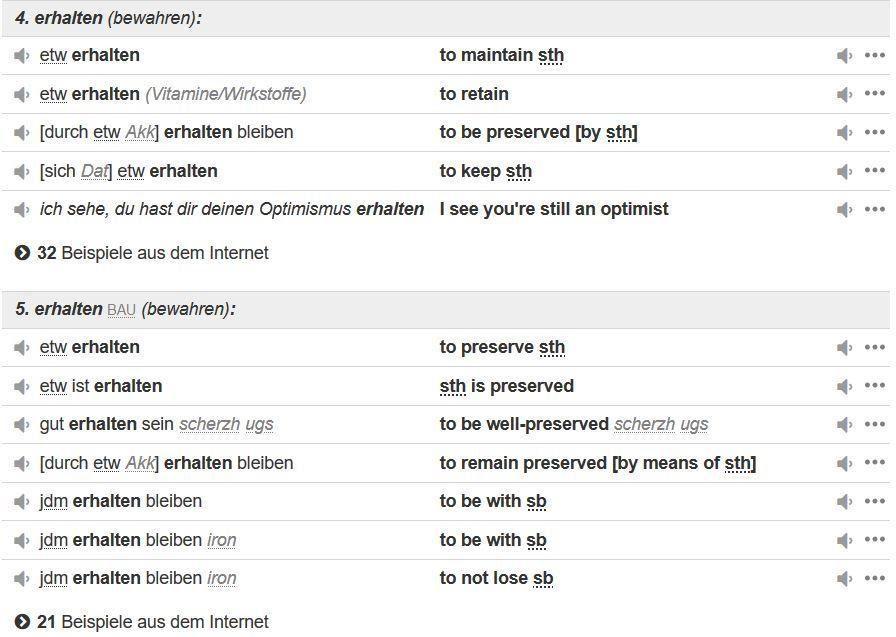
Seeing that there are obviously several possible English translations (maintain, retain, keep, preserve), students will understand that they need another tool to find out which of the translations is appropriate in the example sentence. This point gives you the perfect opportunity to introduce the world of corpora and corpus work generally by subsequently presenting the concordance lines for “verb + biodiversity” using the “Collocates”- function on www.english-corpora.org (Fig. 12).
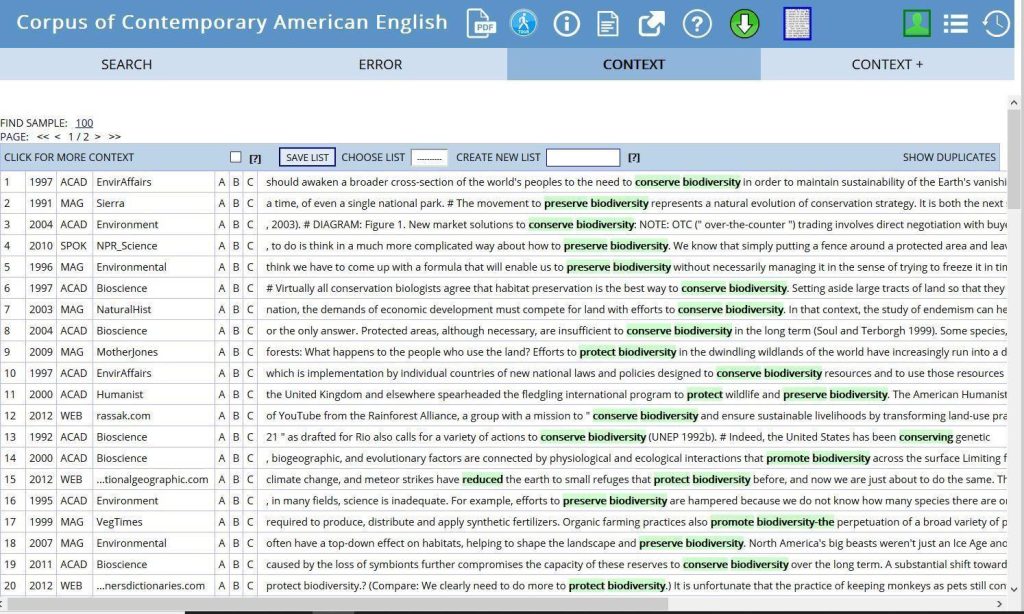
The warm-up demonstrates that one-to-one translations using dictionaries do not necessarily yield the right results but that research on actual language use in context is needed. By introducing and discussing the concordance lines, you not only provide a first example of data-driven learning, but also give students a taste of what they will be working with during the upcoming lessons. However, you should point out that this list of examples is not representative and does not allow for an immediate conclusion as to which verb is most suitable for translating Wir müssen die Artenvielfalt erhalten. The final answer will be given in the warm-up activity of the next lesson.
Preparation
Before students can start working with the corpus, they need to register on the website and create a virtual corpus. For this purpose, hand out Worksheet A and guide the learners through the instructions (“Preparation of our corpus work”).
Ask a student to come to the front to create their account and the virtual corpus on the interactive whiteboard while giving them the necessary instructions. In the meantime, the other students follow those steps on their own computers.
Practice
As preparation for their task, show your students how to use the “List”-function by going through the steps on the whiteboard while they follow them on their computers. Just as in the preparation phase, use the word sustainability as an example to show how the “List”-function works.
Explain that the resulting concordance lines are the most fundamental function of corpus work, since each of these concordance lines displays a different, authentic, contextual use of the word sustainability.
After this introduction, students can continue with the practice tasks on the worksheet either individually or in pairs. Note that the worksheet includes step-by-step instructions as additional support.
The task requires students to implement what they have learnt about corpus work by searching for nouns that occur with sustainable and aims to expand their vocabulary to improve their language for this project. To this end, students will be asked to write their own sentences using the word combinations they found. Tell your students that they can use these or similar sentences for their project later on.
Use the remaining five to ten minutes of the lesson for the students to share their results (both the words and example sentences from the corpus, and their own sentences) and to talk about and answer issues and questions.
3.3 Lesson 2
Teacher preparation
Collecting vocabulary for the mind map
As an introduction to the lesson students create a mind map of their existing vocabulary knowledge which could be relevant for their chosen topics. The mind map should display the topics that the groups have chosen (Fig. 13).
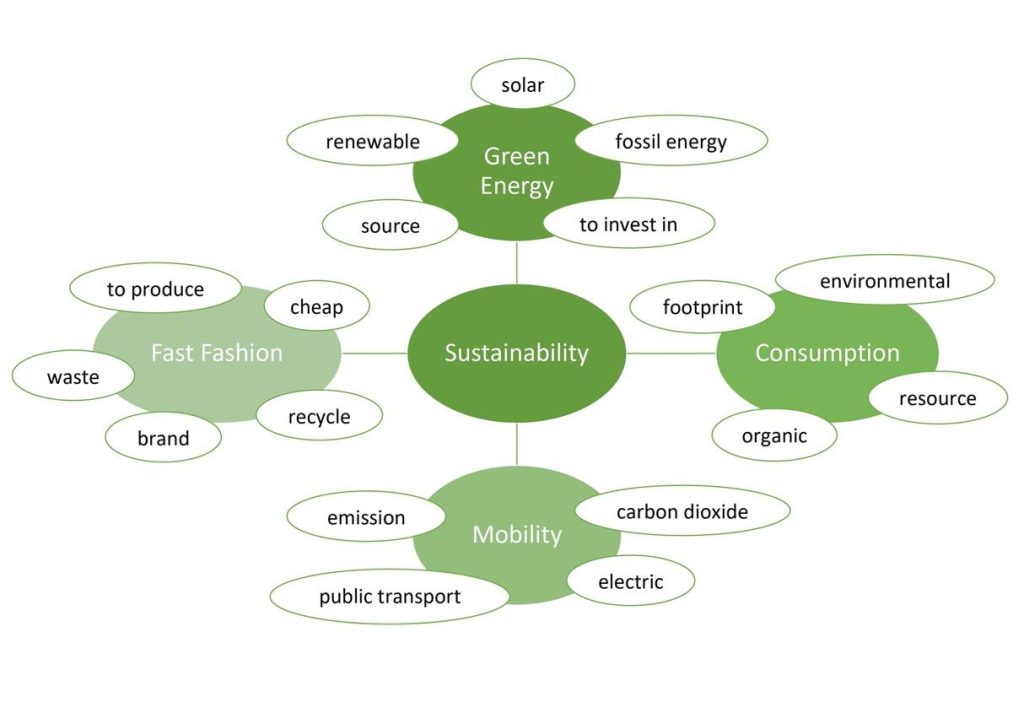
You can prepare the main skeleton of the mind map (sustainability in the middle and the topics of the group projects) on the board or, if available, on an interactive whiteboard before the lesson.
Use the teaching material from previous lessons to note down vocabulary that you can expect students to come up with for each of their topics. Additionally, use the corpus to collect more key vocabulary and further ideas to help you guide the discussion in class and to make sure that the key terms for each topic are included in the mind map.
To browse for keywords in the virtual corpus, go to www.english-corpora.org and ensure that you are logged into your account. Then, go to the COCA again and select “Texts/Virtual.” Click on “Edit corpora” to access your virtual corpus (Fig. 14).
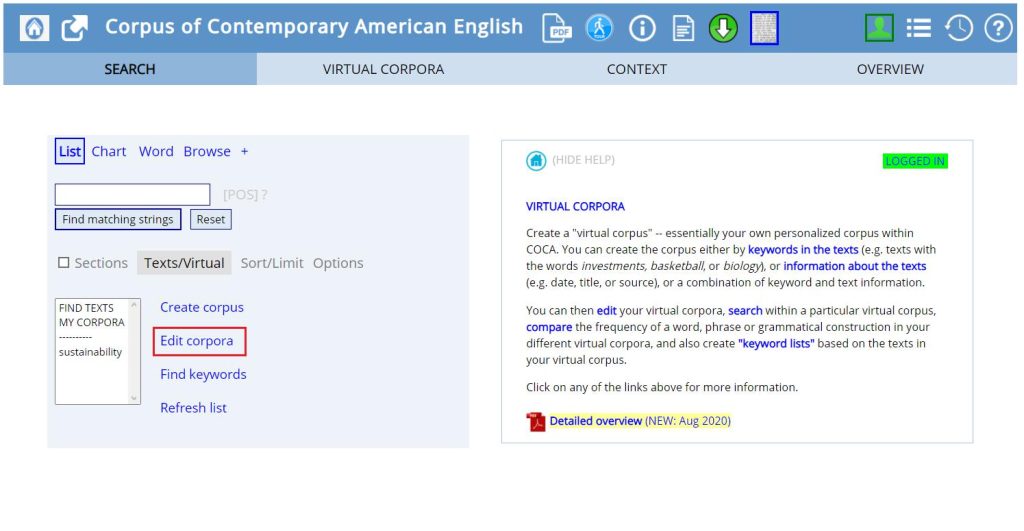
You now see the page that contains information about your corpus. In the column “FIND KEYWORDS”, click on “NOUNS” (Fig. 15) to obtain a list of nouns that are particularly frequent in your corpus as compared to a large reference corpus of general English (Fig. 16).

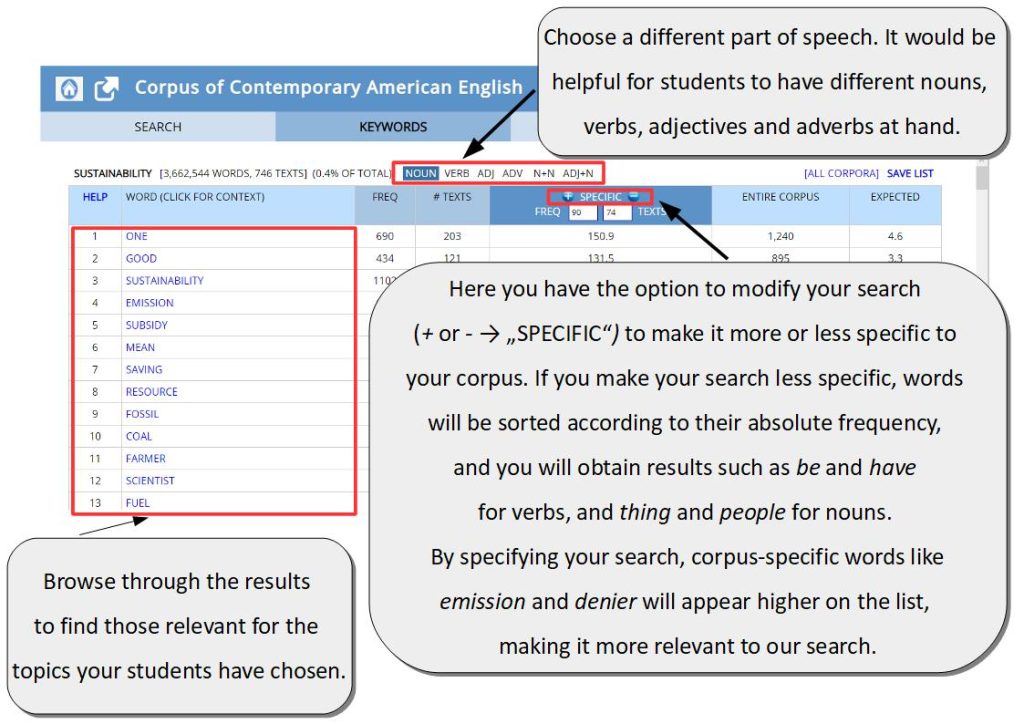
Do have in mind that your students will search for collocations during the lesson to expand their vocabulary in this way, meaning the words on the mind map should predominantly be words they have come across before.
When you find words in the keywords list, you can also click on the word to see the concordance lines for this word. This might be helpful to find out in what contexts a word is used, and to make sure that the word is relevant to your students’ topics.
Tasks and instructions
Plan for the second lesson
Duration: 90 minutes
| Phase | Task |
Implementation |
Interaction form |
Materials |
| (1) Warm-Up 5 min |
Translating:Wir müssen die Artenvielfalt erhalten. | Presenting results of the “Collocates”-function for verb + biodiversityDiscussion of results | Plenum | Electronic devices* |
| (2) Introduction I 10 min |
Mind mapping | Finding vocabulary for topics on sustainability | Plenum | Electronic devices, textbook |
| (3) Introduction II 10 min |
Vocabulary guide (1) | Deciding on keywords for blogs Filling in the “Draft structure” and “Keywords” column |
Project groups | Electronic devices, Worksheet C |
| (4) Preparation 15-20 min |
Getting to know the “Collocates”- function | Using the step-by-step guide on the worksheet to find noun collocates of sustainable in the corpus | Individual/ partner work | Electronic devices, Worksheet B |
| (5) Practice 35-45 min |
Working on the project: Vocabulary guide (2) | Researching suitable vocabulary for blogs Completing the vocabulary guide by using the “Collocates”- function |
Project groups | Electronic devices, Worksheet B, Worksheet C |
| (6) Conclusion and reflection 5-10 min |
What did we learn? What can we do better? | – Discussion of ideas and questions; providing outlook of next lessons | Plenum | ——- |
* = interactive whiteboard, students’ computers/laptops
Warm-up
Begin again by presenting your sentence (Wir müssen die Artenvielfalt erhalten.) on the whiteboard and asking the learners: What can you say about the translation of this sentence into English? The following class-discussion partly recaps the content of the last lesson (problem of one-to-one translations, importance of corpus work and collocations). You can now tell them how you used the “Collocates”-function to come up with a list of verbs which are most frequently used in front of biodiversity. Show them the screenshot (Fig. 17) and discuss the results with your students.
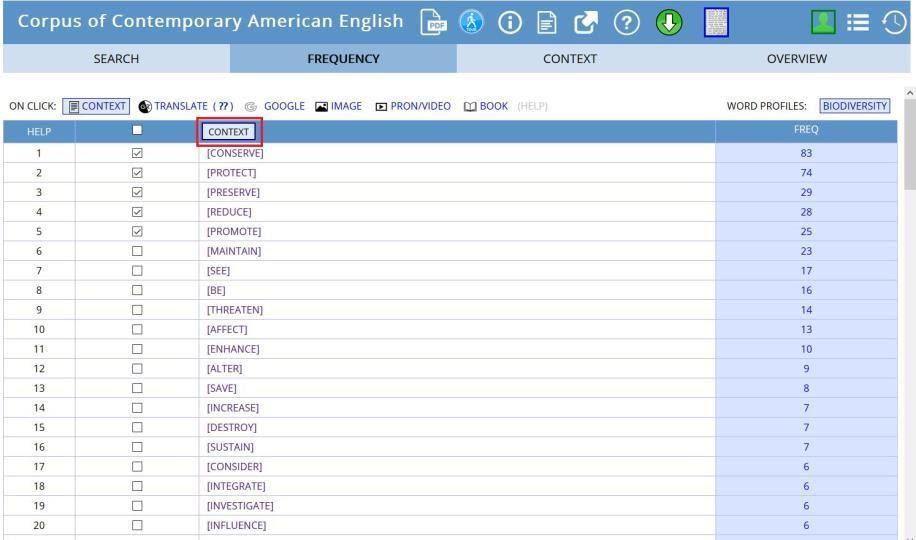
At least in American English, preserve is used much more often than maintain. As a matter of fact, it is the verb conserve that is most likely to occur in front of biodiversity, which is surprising given the fact that it was not mentioned at all in the dictionary entry on www.pons.de.
Use this example to briefly explain what collocations are: though conserve, preserve and maintain all translate as erhalten in German, they cannot be used interchangeably. The verb that is most frequently used with biodiversity appears to be conserve. That means that biodiversity collocates most strongly with conserve. This is what we call a collocation: words that are commonly used together.
Introduction (mind mapping)
Present the prepared mind map to the students, and ask them to think about vocabulary for each of the topics. Stress that all students should think about vocabulary for all topics. This way, every group can receive support and inspiration from their peers. Use the vocabulary collected in preparation for the lesson to guide the discussion so that your students collect a variety of words for different contexts, and also use it to add important words that your students do not mention. To provide more context, ask the groups to briefly state the arguments and ideas they want to address in their project to ensure that the collected vocabulary is relevant to the groups’ project idea.
Introduction (vocabulary guide)
After the class discussion, ask your students to get together in their project groups, and hand out Worksheet C (the worksheet should either be printed in an A3 format or made available as a document on their computers). Explain that this worksheet is a vocabulary guide that the students will devise themselves to prepare for elaborating their products.
Ask the students to fill in the “Draft structure” column with a brief version of the draft structure they have developed in earlier lessons. Afterwards, they should use the mind map to decide on six keywords that are most central to their ideas and topics, and write them in the “Keywords” column (Fig. 18). Ask them to include nouns as well as verbs and adjectives.
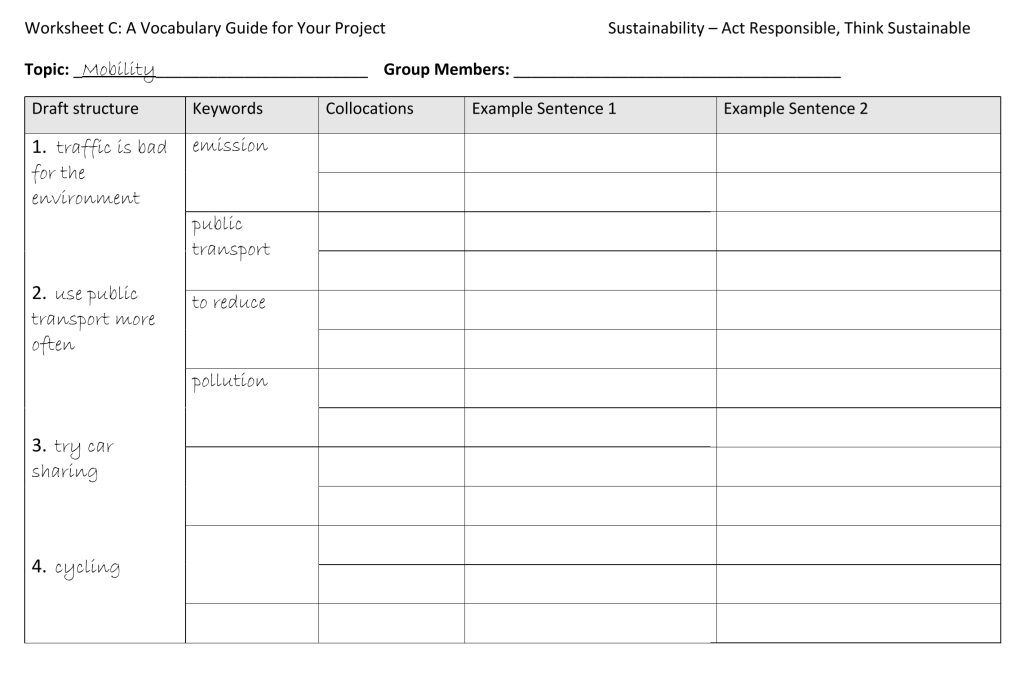
Preparation
After the groups have completed the second column, students should turn to their computers or laptops. Hand out Worksheet B and go through it together. Make sure that all students have a basic understanding of what collocations are, then guide them through the step-by-step instructions while demonstrating the steps on www.english-corpora.org on screen, using sustainability as an example (Fig. 19).
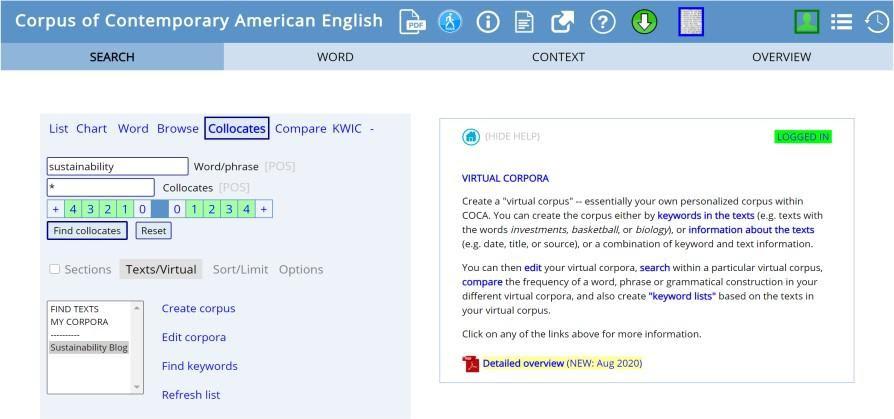
Help your students to understand how the results page (Fig. 20) works as it will look confusing at first: The words are grouped according to their part of speech (POS) and the colours refer to their frequency. The boxes to the left above the table display the word they searched for and its part of speech (e.g., noun). If they have searched for a word that could be more than one POS, they would find an option to switch the POS right next to it (e.g., make can be both a verb and a noun).
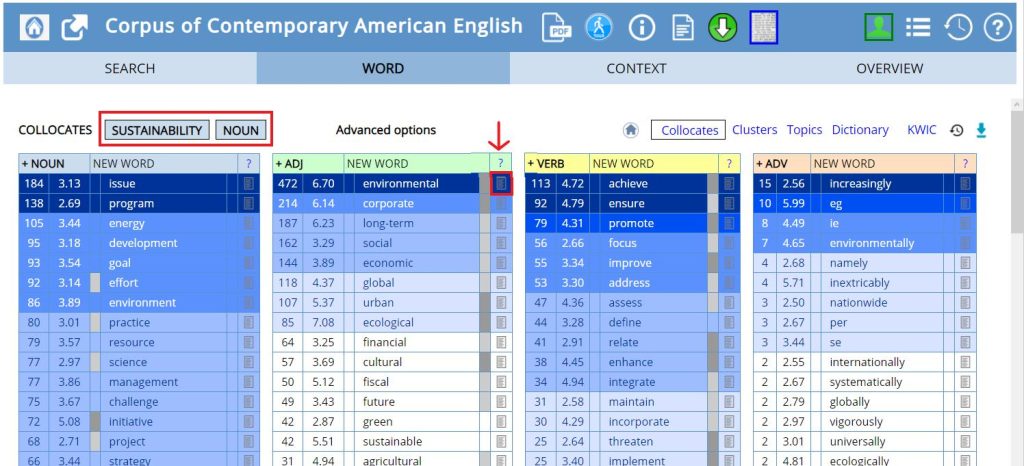
Note that students should not click on the words but on the text icon next to the words to see the concordance lines (Fig. 21). Clicking on the word itself redirects to the collocations of that particular word. If you then go back to the previous page and request the concordance lines again, the interface will show you the concordance lines for the word you clicked on before rather than the concordance lines for sustainability (your search word). To fix this error, you need to launch your search again.
Tip: It might help to ask your students to ensure that two different words are highlighted in the concordance lines, one of which should be their search term. If that is not the case, the aforementioned error has been made and the students need to go back to the search form.
When going to the concordance lines, do not forget to randomise your search by clicking on a number after “Find sample”.
After going through the instructions, students form pairs and search for collocations of sustainable with the help of the step-by-step-guide to practise using the “Collocates”-function.
Tell your students to use the checklist on Worksheet B as a guideline to help them choose suitable collocations: Point out that students should look for new words rather than words that they have used already in the lesson before, i.e., focusing on verbs, adjectives and adverbs rather than nouns. They should also check that they understand how to use the word by checking the example sentences from the concordance lines. By writing a sentence for each collocation themselves, students can test whether they have really understood how to use the collocation in context.
Practice: Working on the project
Ask your students to get back together in their project groups and use the step-by-step guide, as well as the checklist on their worksheet (Worksheet B), to search for collocations for the keywords they have chosen (Worksheet C, Fig. 21). They can refer to the tasks on sustainable for support. Students then work on completing the table in their groups. Ask your students to underline the construction in the example sentences in which the collocation occurs.
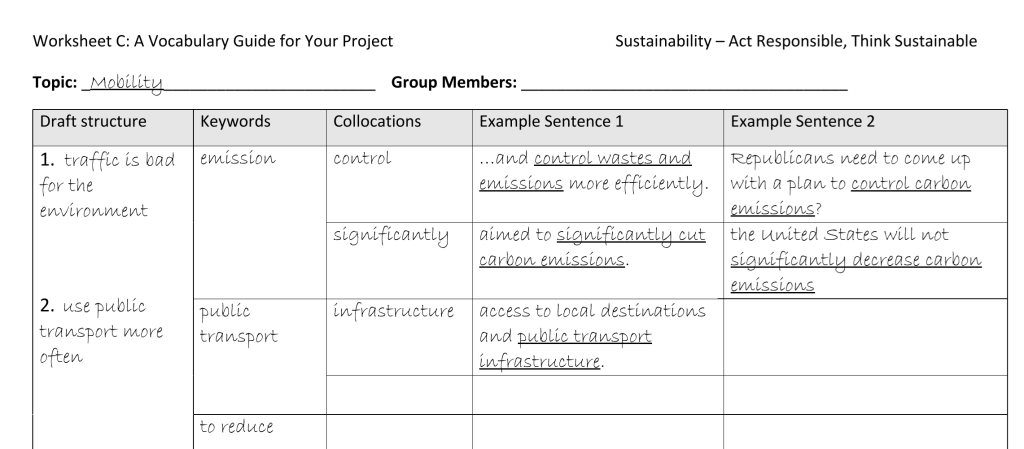
After finishing the table, students can use the new words and example sentences to write their own sentences with the collocations or to start the first paragraph of their final project. Students need to apply the collocation in a construction that mirrors the one from the respective example sentence.
Finish the lesson with a class discussion on the results of the group work.
4 Options and further ideas
Topics
The topic chosen in this chapter is exemplary and could be narrowed down for more support, or replaced by another subject that is deemed relevant and suitable for the students, e.g.:
- Bullying: cyber bullying, peer pressure, …
- Social networks: anonymity, abusive language, benefits, risks, …
- Corona crisis: threats, vulnerabilities, measures, public health policies, economic impact, face masks, …
Project outcomes
The proposed lessons can be used to prepare for various project tasks, e.g.:
- Creating a video or podcast
- Writing a blog entry
- Staging an interview
- Doing a role play / creating a sketch
Differentiation
The worksheets and the step-by-step guide will provide enough scaffolding for most students to be able to work on the tasks independently in their groups. However, for more support you could reduce the number of collocations and/or the number of keywords for individual groups or the whole class, or fill in parts of the vocabulary guide (Worksheet C), e.g., the “Collocations” column, and leave the rest of the table for the students to complete it, e.g., the “Example sentences” column.
Additional tasks
During the writing process, the “Collocates”-function can be continuously used to help students write their texts, e.g., by looking up collocations during the writing phase when they are unsure how to use words correctly, using the “Collocates”-function to improve their first drafts: Ask your students to read through their own (or another group’s) text and extract a certain number of phrases which they would like to improve. Then ask them to find collocations for these words to express their idea in a more idiomatic way.
5 Caveats and limitations
The lessons depend heavily on the availability of end devices for all students; it is assumed that each student has a computer, laptop or tablet they can use in class. If that is not the case, you can adjust the exercises by forming groups for the tasks.
Moreover, a secure and stable internet connection is necessary for these tasks, which the teacher should test in advance. Nonetheless, it is possible that the website gets overloaded if all students simultaneously search for the same things. This can be solved by forming pairs or groups that work on one computer at a time.
6 Conclusion
Although the outline of this project may appear labour-intensive at first, it sets the basis for further corpus-based learning and is therefore quite sustainable and time-saving in the long run. Once the teacher and students have acquired the necessary technical skills, they can be used again and expanded in future projects on any topic. Most importantly, students not only learn how to obtain linguistic support for their writing, but also develop a deeper understanding of how language works, i.e., in patterns rather than by the combination of individual words. Learning new words and phrases in context by actively and autonomously searching for collocations that suit their needs, students are likely to remember the new words better and to use them idiomatically. In this way, the designed lessons are in line with current evidence from second language acquisition research, which highlights the importance of rich exposure, noticing, learner relevance, and emotional as well as cognitive engagement.
7 Resources and references
Corpus of Contemporary American English (COCA). https://www.english-corpora.org/coca/.
Niedersächsisches Kultusministerium. 2015. Kerncurriculum für die integrierte Gesamtschule, Schulgänge 5-10: Englisch. https://cuvo.nibis.de/cuvo.php?p=download&upload=66.
Figures used on Worksheet A: https://www.digitale-nachhaltigkeit.ch/icons-voraussetzungen/ and https://www.english-corpora.org/images/words.jpg
Figure used on Worksheet B: https://pixnio.com/objects/toys/puzzle-pieces-symbol-connect-hand-jigsaw
8 Appendix
Worksheet A
Worksheet B
Worksheet C
